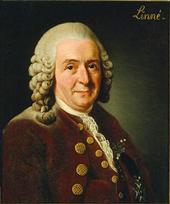I was born on the 23rd of May, 1707, in Rashult, Smaland, Sweden. I am the son of Nils Linnaeus, a Lutherian priest. My father introduced me to botany when I was a young boy, I recall that he would hang flowers from my cradle to pacify me when I cried! At the age of five he gave me small plot in the family garden at Strenbrohult. He was dissapointed to find that I had little interest in becoming a priest. I would often play truant and preferred to study th natural world that surrounded me. My school tutors dissaproved of my interest in the outdoors and told my father that I would make nothing of book learning, they suggested that I should become a craftsman instead! However my natural history teacher, Dr. Rothman, suggested that I should study medicine. At that time, medicine was considered a low status profession, but given the opportunity within the discipline to study natural science, it suited me very well.
In 1727 I began my studies at Lund University. I rented a room from physician, Killian Stobaeus. Stobaeus had a wondeful collection of animals, plants and books. I was not allowed access to this library, but at night used to sneak in to borrow books. Stobaeus found out and took pitty on me and we became good companions, he even allowed me to accompany him on his rounds! I spent one year at Lund, during this time I took every opportunity to explore the countryside of Skane. My old tutor, Dr Rothman visited me at Lund and suggested that I should attend the university of Uppsala. Rothman believed that Uppsala had a better facilities and a well stocked garden that would be more suited to my interests.
Contrary to Dr Rothman's beliefs the medical teaching at Uppsala was poor. Olof Rudbeck, professor of botany, zoology, pharmacology and keeper of the botanical garden was a tired elderly man who had little energy for lectures and the garden. Things were not going well at Uppsala and I quickly ran out of money, however I had the good fortune to cross the path of path Olof Celsius, professor of theology and dean at Uppsala (also uncle of Anders Celsius, who invented the centigrade temperature scale). Celcius, impressed by my knowledge and passion for plants, offered me a free room and fed me, in return I assisted him with two projects. The first concerned plants featured in the bible 'Hierobotanicon'. I then wrote 'Praeludia Sponsaliorum Plantarum', a book that developed my thoughts on the sexual life of plants. This work brought me to the attention of Olof Rudbeck, who hired me to demonstrate plants in the botanic garden. I restored the garden and many changes, I introduced rare plants from the wild and planted them in a systematic way. Today the garden looks much the same way as when I looked after it.
Myspace Layouts at Pimp-My-Profile.com / November - Image Hosting
Find me on MySpace and be my friend!
